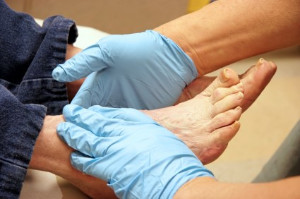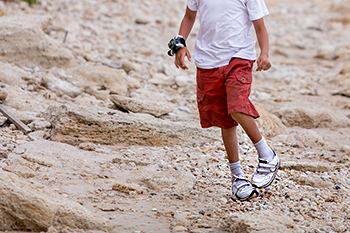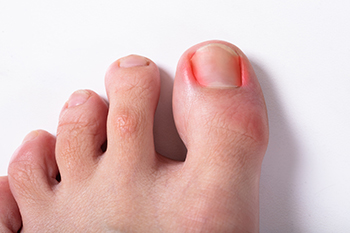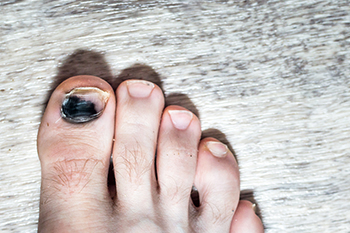Connect With Us
Blog
Items filtered by date: March 2024
Plantar Warts Can Be Treated!
Surgical Debridement in Saving a Limb

Surgical debridement is a critical procedure in foot wound care, involving the removal of dead, damaged, or infected tissue to promote healing. It is commonly used for severe wounds, ulcers, and burns where other methods may not be effective. During the procedure, a podiatrist uses surgical tools to carefully remove the affected tissue, ensuring that healthy tissue remains intact. This process helps to eliminate sources of infection and encourages the growth of new tissue. Surgical debridement can be performed in various settings, including hospitals, clinics, and specialized wound care centers. Depending on the extent of the wound, anesthesia may be necessary to minimize discomfort. After debridement, the wound is typically cleaned and dressed to prevent infection and support the healing process. Proper wound care and follow-up are essential for optimal outcomes following surgical debridement. If you have problematic foot wounds, it is strongly suggested that you schedule an appointment with a podiatrist to see if you can benefit from surgical debridement.
Limb salvage can be an effective way in preventing the need for limb amputation. If you have diabetes, cancer, or any other condition that could lead to foot amputation if left unchecked, consult with one of our podiatrists from Clover Podiatry. Our doctors will assess your condition and provide you with quality foot and ankle treatment.
What Is Limb Salvage?
Limb salvage is the attempt of saving a limb, such as the foot from amputation. Podiatrists also try to make sure that there is enough function in the foot after the salvage that it is still usable. Diabetes is the number one cause of non-traumatic amputations in the United States. Those with diabetes experience poor blood circulation, which prevents proper healing of an ulcer. If the ulcer is left uncheck, it could become infected, which could result in the need for amputation.
However, there are other causes as well, such as cancer and traumatic injury. Links between higher mortality rates and amputation have been found. This translates into higher healthcare costs, and a reduced quality of life and mobility for amputees. Podiatrists have attempted to increase the prevalence of limb salvage in an attempt to solve these issues.
Diagnosis and Treatment
Limb salvage teams have grown in recent years that utilize a number of different treatments to save the infected limb. This includes podiatrists that specialize in wound care, rehabilitation, orthotics, and surgery. Through a combination of these methods, limb salvage has been found to be an effective treatment for infected limbs, and as an alternative to amputation. Podiatrists will first evaluate the potential for limb salvage and determine if the limb can be saved or must be amputated.
If you have any questions, please feel free to contact our offices located in Camas and Vancouver, WA . We offer the newest diagnostic and treatment technologies for all your foot care needs.
How a Podiatrist Can Make a Difference With Clubfoot

Clubfoot is a congenital condition where a baby's foot is twisted inward, making walking difficult. It can affect one or both feet. Podiatrists play a vital role in managing clubfoot. They assess the severity of the condition through physical examinations and imaging tests. Treatment often involves a combination of gentle manipulation, casting, and bracing to gradually correct the foot's position. Podiatrists closely monitor the progress and adjust treatment accordingly to ensure optimal outcomes. In some cases, surgical intervention may be necessary. Podiatrists also provide valuable guidance and support to parents, educating them on proper foot care and exercises to promote normal development. If your child was born with clubfoot, it is strongly recommended that regular appointments with a podiatrist are scheduled. Early intervention can significantly improve the prognosis, helping your child lead a more active and fulfilling life without the limitations imposed by this condition.
Congenital foot problems require immediate attention to avoid future complications. If you have any concerns, contact one of our podiatrists of Clover Podiatry. Our doctors can provide the care you need to keep you pain-free and on your feet.
Congenital foot problems are deformities affecting the feet, toes, and/or ankles that children are born with. Some of these conditions have a genetic cause while others just happen. Some specific foot ailments that children may be born with include clubfeet, polydactyly/macrodactyly, and cleft foot. There are several other foot anomalies that can occur congenitally. What all of these conditions have in common is that a child may experience difficulty walking or performing everyday activities, as well as trouble finding footwear that fits their foot deformity. Some of these conditions are more serious than others. Consulting with a podiatrist as early as possible will help in properly diagnosing a child’s foot condition while getting the necessary treatment underway.
What are Causes of Congenital Foot Problem?
A congenital foot problem is one that happens to a child at birth. These conditions can be caused by a genetic predisposition, developmental or positional abnormalities during gestation, or with no known cause.
What are Symptoms of Congenital Foot Problems?
Symptoms vary by the congenital condition. Symptoms may consist of the following:
- Clubfoot, where tendons are shortened, bones are shaped differently, and the Achilles tendon is tight, causing the foot to point in and down. It is also possible for the soles of the feet to face each other.
- Polydactyly, which usually consists of a nubbin or small lump of tissue without a bone, a toe that is partially formed but has no joints, or an extra toe.
- Vertical talus, where the talus bone forms in the wrong position causing other bones in the foot to line up improperly, the front of the foot to point up, and the bottom of the foot to stiffen, with no arch, and to curve out.
- Tarsal coalition, when there is an abnormal connection of two or more bones in the foot leading to severe, rigid flatfoot.
- Cleft foot, where there are missing toes, a V-shaped cleft, and other anatomical differences.
- Macrodactyly, when the toes are abnormally large due to overgrowth of the underlying bone or soft tissue.
Treatment and Prevention
While there is nothing one can do to prevent congenital foot problems, raising awareness and receiving neonatal screenings are important. Early detection by taking your child to a podiatrist leads to the best outcome possible.
If you have any questions please feel free to contact our offices located in Camas and Vancouver, WA . We offer the newest diagnostic tools and technology to treat your foot and ankle needs.
A Podiatrist’s Approach to Ingrown Toenails
 When you have an ingrown toenail, it means that the edge of the nail is growing into the skin around it. A podiatrist, who is a foot doctor, has several approaches to treatment, which can range from conservative to surgical. A podiatrist may perform a nail-lifting procedure by using cotton or gauze to separate the nail edge from the skin. If the ingrown toenail keeps coming back or is severe, a podiatrist can also perform a small surgery. This usually involves removing a part of the nail and sometimes a bit of the skin around it to stop the nail from growing into the skin again. The podiatrist can make sure you're comfortable during the procedure by using local anesthetics. If you’re suffering from an ingrown toenail, it is suggested that you seek treatment with a podiatrist, who can both treat your toe and give you advice on how to prevent the problem from coming back.
When you have an ingrown toenail, it means that the edge of the nail is growing into the skin around it. A podiatrist, who is a foot doctor, has several approaches to treatment, which can range from conservative to surgical. A podiatrist may perform a nail-lifting procedure by using cotton or gauze to separate the nail edge from the skin. If the ingrown toenail keeps coming back or is severe, a podiatrist can also perform a small surgery. This usually involves removing a part of the nail and sometimes a bit of the skin around it to stop the nail from growing into the skin again. The podiatrist can make sure you're comfortable during the procedure by using local anesthetics. If you’re suffering from an ingrown toenail, it is suggested that you seek treatment with a podiatrist, who can both treat your toe and give you advice on how to prevent the problem from coming back.
Ingrown toenails can become painful if they are not treated properly. For more information about ingrown toenails, contact one of our podiatrists of Clover Podiatry. Our doctors can provide the care you need to keep you pain-free and on your feet.
Ingrown Toenails
Ingrown toenails occur when a toenail grows sideways into the bed of the nail, causing pain, swelling, and possibly infection.
Causes
- Bacterial infections
- Improper nail cutting such as cutting it too short or not straight across
- Trauma to the toe, such as stubbing, which causes the nail to grow back irregularly
- Ill-fitting shoes that bunch the toes too close together
- Genetic predisposition
Prevention
Because ingrown toenails are not something found outside of shoe-wearing cultures, going barefoot as often as possible will decrease the likeliness of developing ingrown toenails. Wearing proper fitting shoes and using proper cutting techniques will also help decrease your risk of developing ingrown toenails.
Treatment
Ingrown toenails are a very treatable foot condition. In minor cases, soaking the affected area in salt or antibacterial soaps will not only help with the ingrown nail itself, but also help prevent any infections from occurring. In more severe cases, surgery is an option. In either case, speaking to your podiatrist about this condition will help you get a better understanding of specific treatment options that are right for you.
If you have any questions please feel free to contact our offices located in Camas and Vancouver, WA . We offer the newest diagnostic and treatment technologies for all your foot and ankle needs.
Causes of Blackened Toenails

Blackened toenails are caused by repetitive pressure and friction, often occurring when the toe is forced against the front edge of a shoe's toe box. While sometimes referred to as tennis toe, blackened toenails can also affect athletes in soccer, football, squash, racquetball, basketball, running, and skiing. Symptoms include throbbing pain and a reddish-blue or black discoloration of the nail plate due to a subungual hematoma, which is caused by blood under the nail. The big toe is more commonly affected in blackened toenails, but the second toe may also be affected. Wearing ill-fitting shoes plays a pivotal role, causing friction that leads to bleeding under the toenail. In severe cases with significant bleeding, swelling, or infection, visiting a podiatrist is suggested. This foot doctor may relieve pressure on the subungual hematoma by making a small hole in the nail or, in extreme cases, recommend partial or complete nail removal. Prevention involves wearing well-fitted shoes and recognizing early symptoms. Whether you are an avid athlete or enjoy an active lifestyle, if you notice discoloration in the toenails, it is suggested that you schedule an appointment with a podiatrist for treatment solutions.
Toe pain can disrupt your daily activities. If you have any concerns, contact one of our podiatrists of Clover Podiatry. Our doctors can provide the care you need to keep you pain-free and on your feet.
What Causes Toe Pain?
Most severe toe pain is caused due to a sports injury, trauma from dropping something heavy on the toe, or bumping into something rigid. Other problems can develop over time for various reasons.
Toe pain can be caused by one or more ailments. The most common include:
- Trauma
- Sports injury
- Wearing shoes that are too tight
- Arthritis
- Gout
- Corns and calluses
- Hammertoe
- Bunions
- Blisters
- Ingrown toenails
- Sprains
- Fractures (broken bones)
- Dislocations
When to See a Podiatrist
- Severe pain
- Persistent pain that lasts more than a week
- Signs of infection
- Continued swelling
- Pain that prevents walking
Diagnosis
In many cases the cause of toe pain is obvious, but in others, a podiatrist may want to use more advanced methods to determine the problem. These can range from simple visual inspections and sensation tests to X-rays and MRI scans. Prior medical history, family medical history, and any recent physical traumatic events will all be taken into consideration for a proper diagnosis.
Treatment
Treatments for toe pain and injuries vary and may include shoe inserts, padding, taping, medicines, injections, and in some cases, surgery. If you believe that you have broken a toe, please see a podiatrist as soon as possible.
If you have any questions please feel free to contact our offices located in Camas and Vancouver, WA . We offer the newest diagnostic tools and technology to treat your foot and ankle needs.

